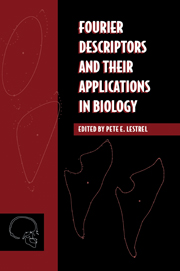Book contents
- Frontmatter
- Contents
- List of contributors
- Preface
- Acknowledgments
- Part one Theoretical considerations
- Part two Applications of Fourier descriptors
- 6 Closed-form Fourier analysis: A procedure for extraction of ecological information about foraminiferal test morphology
- 7 Fourier descriptors and shape differences: Studies on the upper vertebral column of the mouse
- 8 Application of the Fourier method on genetic studies of dentofacial morphology
- 9 Fourier analysis of size and shape changes in the Japanese skull
- 10 Craniofacial variability in the hominoidea
- 11 Heuristic adequacy of Fourier descriptors: Methodologic aspects and applications in Morphological
- 12 Analyzing human gait with Fourier descriptors
- 13 Elliptic Fourier descriptors of cell and nuclear shapes
- 14 Cranial base changes in shunt-treated hydrocephalics: Fourier descriptors
- 15 A numerical and visual approach for measuring the effects of functional appliance therapy: Fourier descriptors
- 16 Size and shape of the rabbit orbit: 3-D Fourier descriptors
- 17 From optical to computational Fourier transforms: The natural history of an investigation of the cancellous structure of bone
- 18 Epilogue: Fourier methods and shape analysis
- Appendix
- Glossary
- Index
16 - Size and shape of the rabbit orbit: 3-D Fourier descriptors
Published online by Cambridge University Press: 14 September 2009
- Frontmatter
- Contents
- List of contributors
- Preface
- Acknowledgments
- Part one Theoretical considerations
- Part two Applications of Fourier descriptors
- 6 Closed-form Fourier analysis: A procedure for extraction of ecological information about foraminiferal test morphology
- 7 Fourier descriptors and shape differences: Studies on the upper vertebral column of the mouse
- 8 Application of the Fourier method on genetic studies of dentofacial morphology
- 9 Fourier analysis of size and shape changes in the Japanese skull
- 10 Craniofacial variability in the hominoidea
- 11 Heuristic adequacy of Fourier descriptors: Methodologic aspects and applications in Morphological
- 12 Analyzing human gait with Fourier descriptors
- 13 Elliptic Fourier descriptors of cell and nuclear shapes
- 14 Cranial base changes in shunt-treated hydrocephalics: Fourier descriptors
- 15 A numerical and visual approach for measuring the effects of functional appliance therapy: Fourier descriptors
- 16 Size and shape of the rabbit orbit: 3-D Fourier descriptors
- 17 From optical to computational Fourier transforms: The natural history of an investigation of the cancellous structure of bone
- 18 Epilogue: Fourier methods and shape analysis
- Appendix
- Glossary
- Index
Summary
Introduction
The form of the vertebrate skull is dependent, in part, on the size and shape of the orbit and its contents. The orbit has been an object of interest to surgeons dealing with the growth of the human eye and its surrounding structures (Sarnat, 1981). Experiments have demonstrated that removal of the orbital contents slows orbital growth as well as affecting other regions of the skull (Sarnat and Shanedling, 1970; 1972). The orbit is bounded superiorly by the supraorbital process attached to the frontal bone and inferiorly by the zygomatic arch. It represents a morphological structure that is not planar, extending significantly into all three planes, and requiring that the orbital margin be modeled as a curve in 3-space (Figure 16.1).
Irregular morphological forms such as the orbital margin are particularly difficult to characterize with conventional numerical methods, hence the lack of information on orbital size and shape changes with either growth or treatment.
Elliptical Fourier functions (EFFs) were chosen to numerically describe the shape changes in the growing orbital margin. This is a curve-fitting procedure based on a converging trigonometric series. The specific descriptor utilized was developed by Kuhl and Giardina (1982), as a parametric two-dimensional solution; that is, a pair of equations as functions of a third variable.
- Type
- Chapter
- Information
- Fourier Descriptors and their Applications in Biology , pp. 359 - 378Publisher: Cambridge University PressPrint publication year: 1997
- 2
- Cited by



